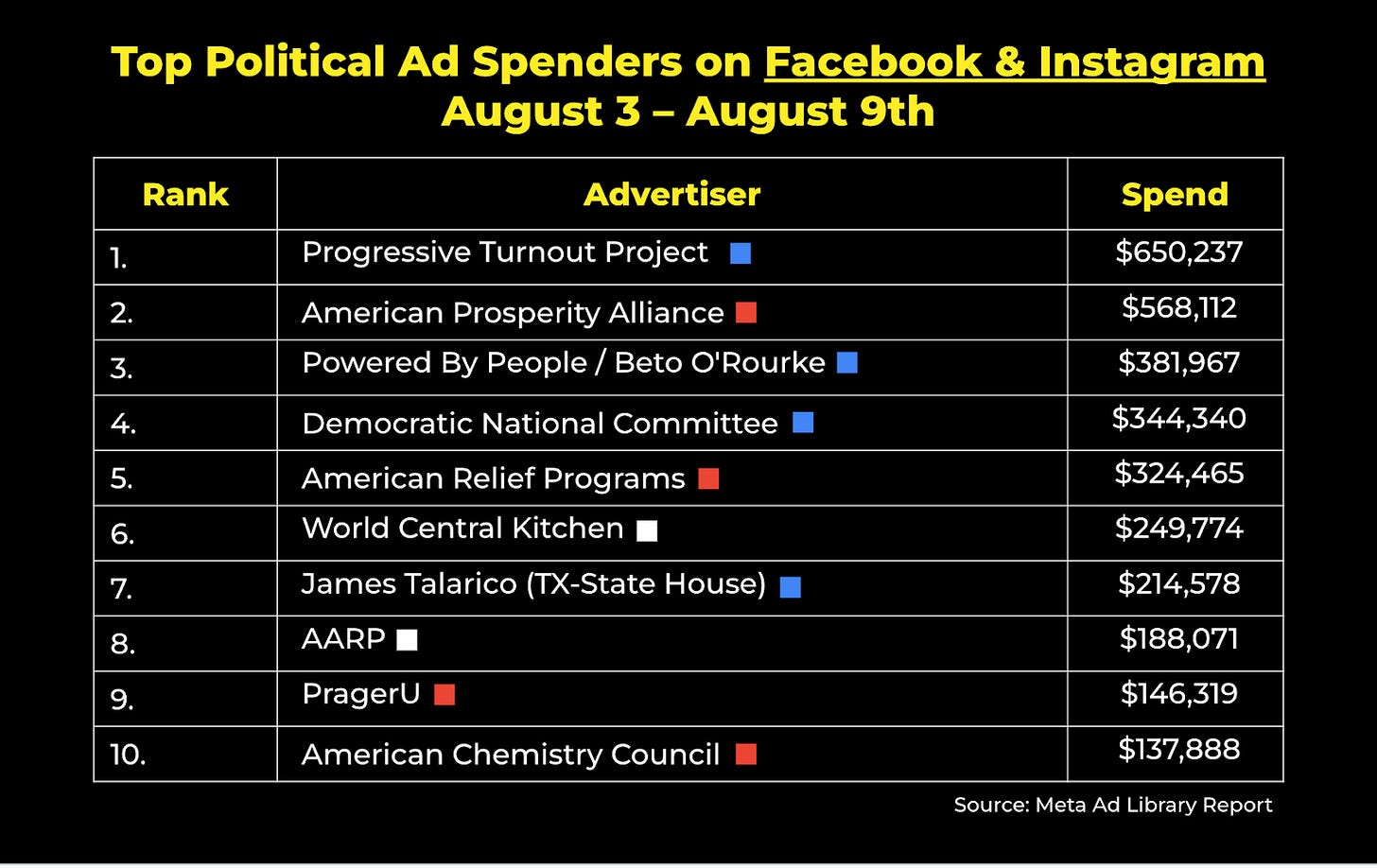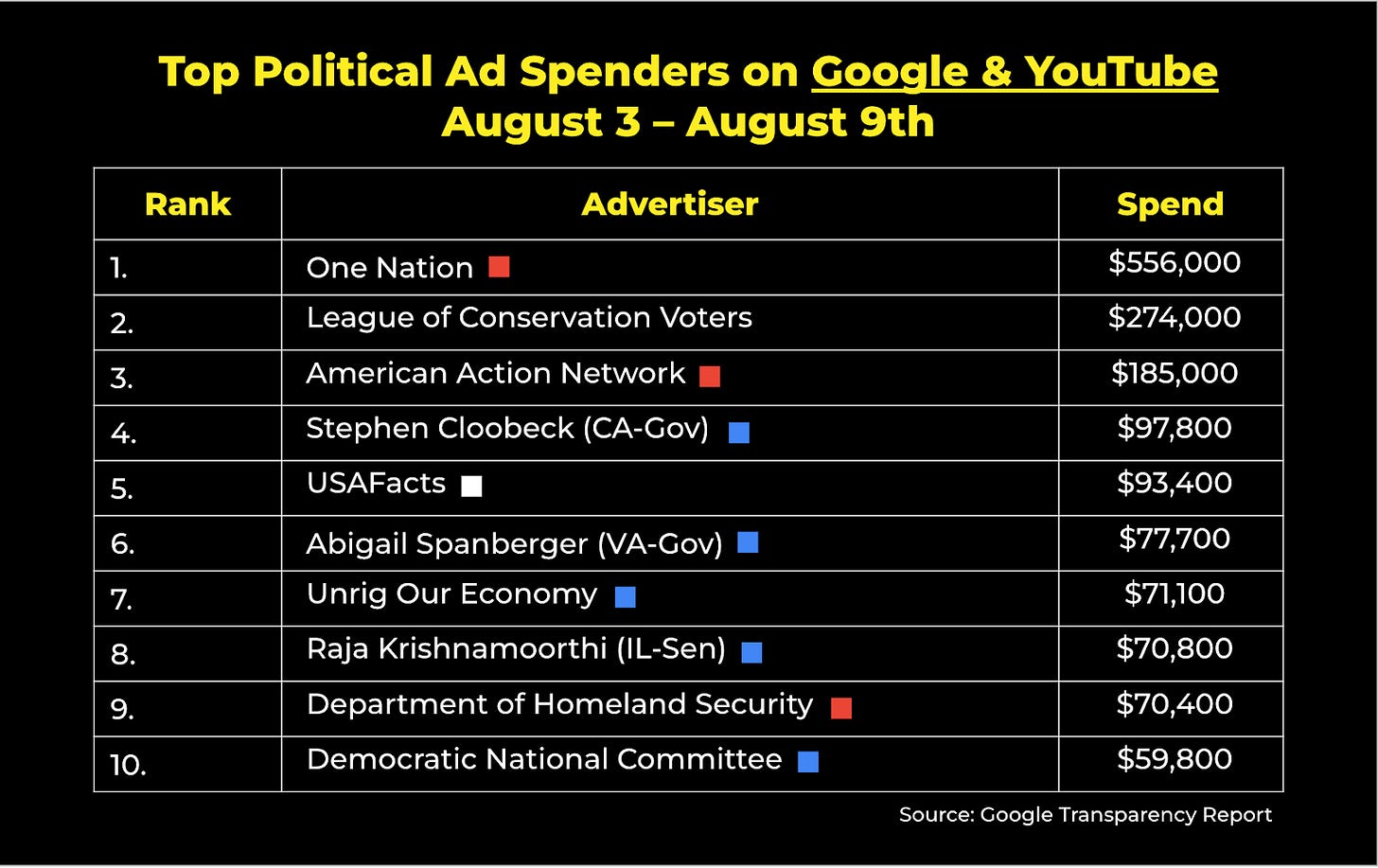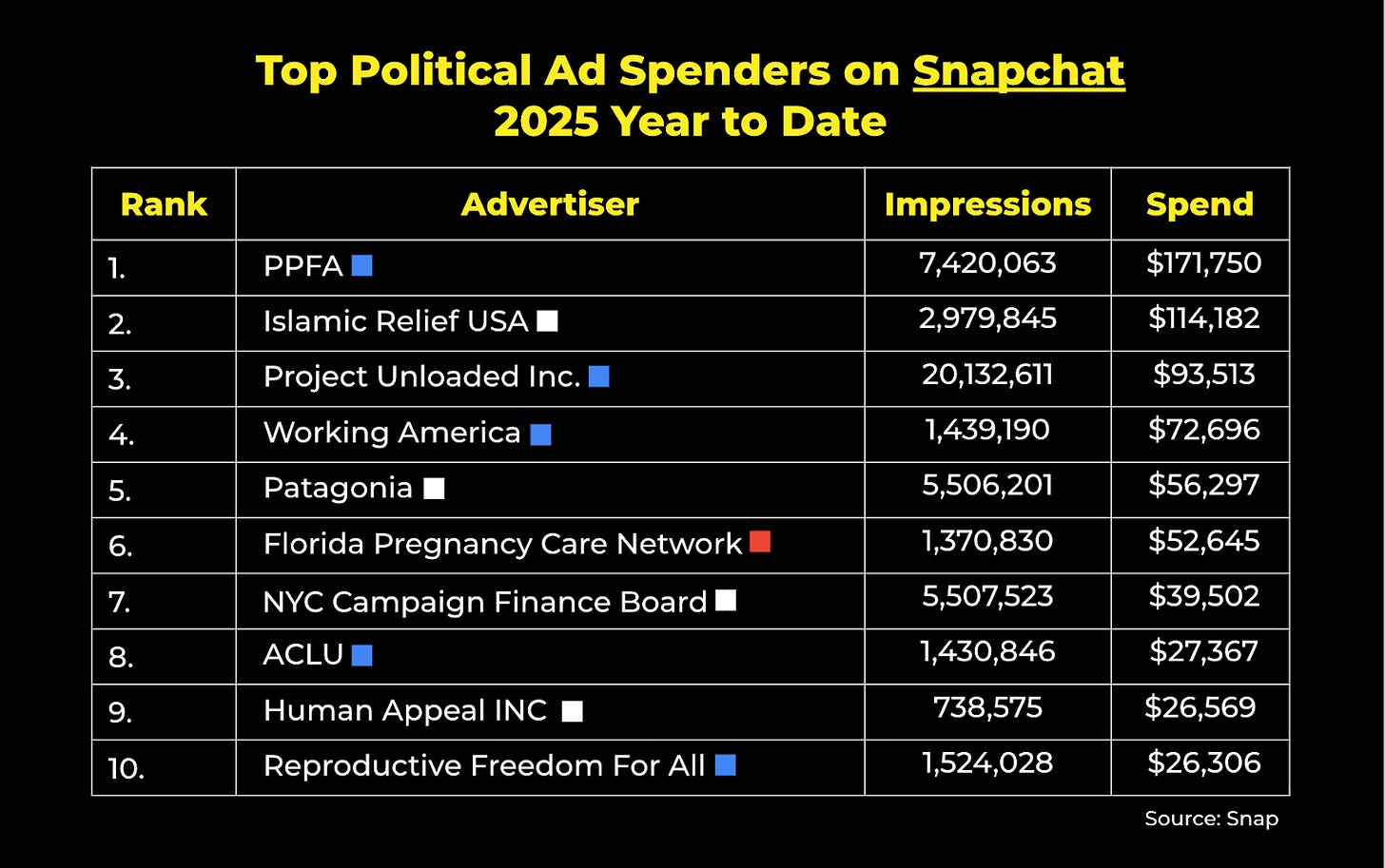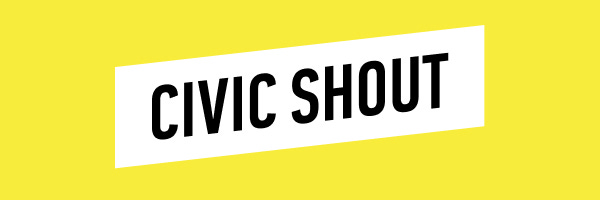Inside PragerU’s Digital Playbook to Change Culture
Also inside: A look at early spending in the Texas Senate primary, ActBlue announces policy changes, and more
This newsletter is sponsored by the donor acquisition approach that helps you turn $1 into $2.
Hi there, it’s your guest author Brian O’Grady, back for another week. In this edition, we’re looking at the massive conservative content farm that is PragerU – and what, exactly, they’re flooding the Internet with. More on that below, but first…
Digital ad spending, by the numbers:
FWIW, U.S. political advertisers spent about $10.6 million on Facebook and Instagram ads last week. Here were the top ten spenders nationwide:
Beto O’Rourke and TX House member James Talarico – both reportedly considering a run for Cornyn’s Senate seat – are list-building off Trump’s redistricting plan. So is Rep Colin Allred, but with just $7,000 in Meta spend this week, he didn’t make this list.
Meanwhile, political advertisers spent just over $2.8 million on Google and YouTube ads last week. These were the top ten spenders nationwide:
Multiple-time Undercover Boss guest + Democrat Stephen Cloobeck, who recently announced for the California Governor’s race, spent just shy of $100k on Google ads this week, alongside a $1.4 million TV buy.
Meanwhile, the Department of Homeland Security continues spending (taxpayer) money on ads featuring Kristi Noem threatening immigrants and thanking Trump.
On X (formerly Twitter), political advertisers in the U.S. have spent around $6 million on ads in 2025. According to X’s political ad disclosure, here are the top spenders year to date:
…and lastly, on Snapchat, political advertisers in the U.S. have spent around $1.1 million on ads in 2025. Here are the top spenders year to date:
Tired of burning money with Care2 or Meta ads?
It’s 2025, and groups like Common Cause, Earthjustice, and Amnesty International are leaning on Civic Shout to acquire ROI-positive donors and activists. See how you can, too.
Inside PragerU’s Digital Playbook to Change Culture
Regular readers will notice that PragerU is a pretty regular fixture in the Meta spending charts we publish every week. This week, they charted at number 9, spending $146,319. Their most-viewed Meta ads this week feature a poll about LGBTQ+ education in schools, a socks ad, and a trans panic video.
So, who exactly is PragerU? And why do they spend so much on Facebook ads?
Founded in 2009 by conservative radio host Dennis Prager and screenwriter Allan Estrin, the group started producing digital video products in 2011, focusing on five-minute videos, targeting college-age viewers with digestible conservative messages. As an example, here’s one of their earliest videos on YouTube.
Since then, they’ve exploded in size, scope, and budget. As of 2023, they employ over 100 people, with a 60-person marketing team. Their revenue has ballooned, from $2.3 million in 2011 to $70 million in 2024. Last year, they spent over $24 million – 35% of their operating budget – on marketing and advertising.
Between 2018 and now, they’ve spent at least $34 million on Meta, making them the all-time 8th-largest political spender on Meta – ahead of the DNC. And although their Google spending is less aggressive, at $6.8 million to date, they rank in the top 50.
Their 2024 annual report boasts an email list of 8.2 million subscribers. Since their founding, they’ve moved beyond their target audience – 18 to 35 year olds – to school-age children. With the PragerU Kids subsection, they’ve developed a content stream for under-18 audiences, including printed storybooks, animated shorts, crafting lessons, and kids game shows. They’re providing lesson plans for public schools in at least nine states. And they’ve gotten into the podcast business.
So, is PragerU a media conglomerate? Well, sort of. Tyler Leeds, a sociologist who published a study of Prager’s social media tactics in November, argues they fit the definition of a think tank, working to influence policy through research and advocacy.
But unlike traditional think tanks, who tend to communicate primarily with policymakers and pundit types, Prager is messaging directly to the general public. And while it’s easy to point to specific policy outcomes (partially) attributable to their work, their target is culture change.
Tactically, Prager’s approach to social media breaks from tradition in a couple key ways. Leeds’s study makes a compelling argument that Prager has found a unique way to thread the needle on content: many of their ads feature both a “microinfluencer” character, projecting charisma, intimacy, authenticity, and an “intellectual” character, projecting authority.
A study by Climate Action Against Disinformation notes that most of their videos aren’t anchored to news cycles (unlike more opportunistic disinformation outlets), making them evergreen video content. Their videos are also notable for being light on macroinfluencers with big personalities – potentially shielding them from unwanted attention when a principal, say, goes hog on some antisemitic tropes. Instead, they lean towards breezy, animated explainers, like this one, on the fall of Rome.
With this in mind, it’s easy to understand why they’d pour so much time and money into paid and organic media. Their paid media can reach millions of users, weekly, on Meta alone. And that kind of reach and engagement dovetails into email subscriptions, organic followers, and small-dollar donors. Moreover, they’re developing new and efficient onboarding paths to the conservative movement, with digestible, friendly, relatively anodyne content. Would-be liberal media behemoths could perhaps do well to study their playbook.
Tired of burning money with Care2 or Meta ads?
It’s 2025, and groups like Common Cause, Earthjustice, and Amnesty International are leaning on Civic Shout to acquire ROI-positive donors and activists. See how you can, too.
More from around the internet:
Join COURIER for REPRESENT: Leading Voices in NYC on Wednesday, September 10th, where you can hear from rising leaders and creators, like Deja Foxx and NC Dems Chair Anderson Clayton, on challenging the old rules of politics, power, and media to shape what comes next. RSVP here!
On the topic of “Dems are getting lapped in the cultural media ecosystem,” Rob Flaherty weighs in on the Sydney Sweeney discourse, asking how Dems let ourselves get into this spot in the first place. COURIER podcast Panic World is also on this Sweeney beat.
ActBlue is rolling out new policies intended to crack down on scam PACs, including banning phony donor matches and implicit but unauthorized endorsements. There’s also a (hazy) mechanism for policing groups that use “excessive solicitations and aggressive fundraising tactics.”
Speaking of aggressive fundraising tactics, Mothership is pushing back on new reporting about its apparent self-dealing, and Micah Sifry pushes back on the pushback.
Reuters reports that internal Meta documents covering AI chatbot policies are particularly permissive when it comes to chatbots flirting with children (and helping racists refine their arguments).
Anti-DEI activist Robby Starbuck will be advising Meta on how to make their AI tools friendlier to conservatives.
That’s it for FWIW this week. This email was sent to 24,515 readers. If you enjoy reading this newsletter each week, would you mind sharing it on X/Twitter, Threads, or Bluesky? Have a tip, idea, or feedback? Reply directly to this email.








